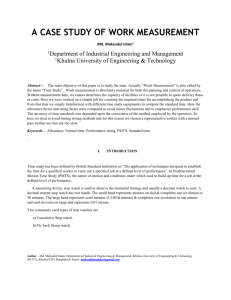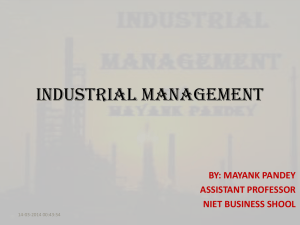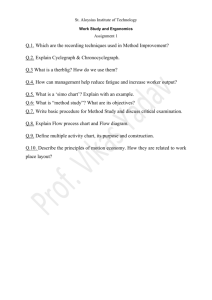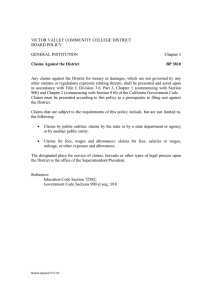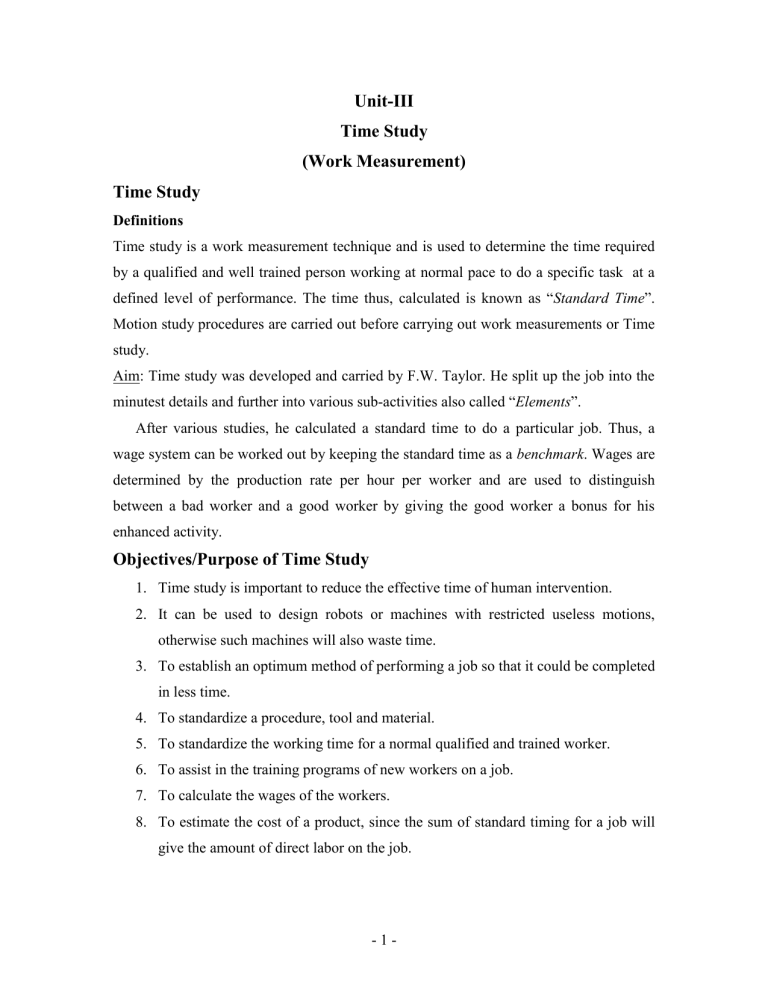
Unit-III Time Study (Work Measurement) Time Study Definitions Time study is a work measurement technique and is used to determine the time required by a qualified and well trained person working at normal pace to do a specific task at a defined level of performance. The time thus, calculated is known as “Standard Time”. Motion study procedures are carried out before carrying out work measurements or Time study. Aim: Time study was developed and carried by F.W. Taylor. He split up the job into the minutest details and further into various sub-activities also called “Elements”. After various studies, he calculated a standard time to do a particular job. Thus, a wage system can be worked out by keeping the standard time as a benchmark. Wages are determined by the production rate per hour per worker and are used to distinguish between a bad worker and a good worker by giving the good worker a bonus for his enhanced activity. Objectives/Purpose of Time Study 1. Time study is important to reduce the effective time of human intervention. 2. It can be used to design robots or machines with restricted useless motions, otherwise such machines will also waste time. 3. To establish an optimum method of performing a job so that it could be completed in less time. 4. To standardize a procedure, tool and material. 5. To standardize the working time for a normal qualified and trained worker. 6. To assist in the training programs of new workers on a job. 7. To calculate the wages of the workers. 8. To estimate the cost of a product, since the sum of standard timing for a job will give the amount of direct labor on the job. -1- Procedure of Conducting Time Study The basic procedure for carrying out time study stepwise is (also see Figure 1): i. Study the job in terms of the workplace, tools, operator, etc. ii. Collect or study all the information about the method (i.e. description of operations). Break each operation into small elements. An element is a distinct part of an operation selected for the convenience of the observation, measurement and analysis. iii. Examine each element for most effective method and motions are being used. iv. Observe and record time for the operator to perform each element of operation. v. Determine number of cycles of observations to be timed and calculate the time by taking the average of all readings. vi. Rate operator performance. vii. Extend the observed time to basic times (or normal time). viii. Determine the allowances (to be provided over and above the basic time). ix. Determine the standard time for the operation. Example: If we analyze work, we see that work can be divided into various stages and for each stage time is recorded. The various stages are: i. Preparatory time. Setting-up time ii. Time for making records. iii. Time for obtaining materials. iv. Setting-up time for machine. v. Time for re-sharpening of tools. Effective time vi. Loading time for the job. vii. Unloading time for the job. viii. Time required shifting the job to next operation. ix. Unsetting time for the job. -2- Select the job for study Select the worker to be timed Breaking the job into sub-elements Timing of each element Averaging Figure 1: Block Diagram Representing Time Study Procedure Rating Deciding allowances Calculating the standard time Time Study Equipments Following equipments are used for time study: 1. Stop watch 2. Time study board 3. Time study forms or sheets 4. Tachometer 5. Motion picture camera and video equipment 6. Electronic data collector and computer. -3- System of Performance Rating Necessity of Performance Rating When number of qualified operators is performing the same activity, their o/p will not be same. Some operators will definitely be producing more than what others are producing, while it is assumed that all the operators are following the same method and working under the same working conditions. As such it is really a problem whose work should be considered as fair day’s work. If the slowest worker is considered as standard then the efficient worker will be considered very fast and ultimately there will be lot of difference between their earnings and thereby it will cause dissatisfaction amongst the workers. As such there should be standard of performance for all the processes and should satisfy the group of workers. Concept of Rating The Society of Advancement of Management National Committee defined Rating as “the assessment of the worker’s rate of working to observer’s concept of the rate corresponding to standard rating”. OR “The process during which the time study engineer compares the performance of the operator under observation with the observer’s concept of proper (normal) or standard performance”. Rating factor may vary from 80-130%. i.e. Performance Rating/Rating Factor= ObservedPerfromance 100 NormalPerformance(orS tan dardPerformance) Note: With the help of rating, the basic time is calculated. Basic/Normal Time When the required number of observations is obtained, the next step is to convert the observed time into basic time. Basic time is defined as “the time for carrying out an element of work at standard rating”. Considering the rating factor and the observer’s time for that element, basic time for that element is found by the following formula: Basic Time= Observedtime Observedrating S tan dardRating -4- = ObservedTime Rating 100 The next step is the addition of various job allowances in order to determine the work content and the standard time. Allowances Allowances are the additional time allowed to perform the work and are above the normal time/basic time. It is an amount of time added to the normal time to provide for personal delays, unavoidable delays, fatigue delays etc. Allowances when added to the normal time/basic time it results in standard time. Need of Allowances o It is not expected that an operator will work all day without some interruption. The workers may take time out for personal needs, for rest and for reasons beyond his control. o To add enough time to the normal production time to enable the average worker to meet the standard when performing at a normal pace. Various Allowances Allowance may be classified as (also see Figure 2): 1. Fatigue Allowance: due to working condition, nature of work (monotony, body movement, stress), general health of worker, physical and mental fatigue. It may vary 12-20% or more. 2. Personal Allowance: for trips to the dressing room, drinking water etc. and is taken as 2-5% in 8hours shift per day. 3. Delay Allowance: for tool breakage, interruption by foremen etc. Delay allowances may be avoidable or unavoidable. For example: idleness due to character or nature of a process or operation. 4. Special Allowance: a. Contingency Allowance: unavoidable delays like: filling coolant in reservoir, tool sharpening, tool breakage, power failure, waiting for in process inventory from previous machines etc. b. Periodic Activity Allowance: Examples setting up of a planer, regrinding a lathe tool etc. -5- c. Interference Allowance: when worker is looking after two or more machines simultaneously. 5. Policy Allowance: They are not the genuine part of the time study and should be used with utmost care and only in special circumstances like wage agreement between employers and trade unions etc. ALLOWANCES Relaxation Allowances Personal Allowances Delay Allowances Special Allowances Fatigue Allowances Avoidable Delay Unavoidable Delay Policy Allowances Contingency Allowances Interference Allowances Periodic Activity Allowances Process Allowances Basic Fatigue Allowances Variable Allowances Figure 2: Branch Diagram Showing Different Types of Allowances Standard Time (ST) It is the time which is taken by a normal worker for doing a specific task or job working under moderate conditions and under normal pace and including other allowances such as fatigue, setting of tool and job, repairing of tool and checking of job etc. Thus, Standard Time (ST)= Average time or observed time ×Rating factor +Allowances ST= Basic Time or Normal Time +Allowances Numerical Problems Example1: Observed time (OT) of an activity=0.5minutes Rating Factor (RF)=125% Allowances=15% of Standard Time (ST). Calculate ST. -6- Example 2: Let us consider another example which is stated as follows: OT=0.75minutes, Relaxation Allowance (RA)= 10% of normal time (NT), Delay Allowance (DA)= 2% of NT, RF= 110%, Personal Allowances (PA)= 3% of NT. Calculate ST. Example3: An industrial operation consists of five elements with following observed times (OTs) and the performance rating: Elements OT (Min.) Performance Rating (%) 1 0.15 80 2 0.20 85 3 0.10 90 4 0.12 75 5 0.25 80 Assuming rest and personal allowances as 12% of basic time (BT) and contingency allowances as 4% of the BT, calculate ST per piece. (Answer: 0.6726 minutes) For Home Assignment Example 4: The elemental data on a power hacksaw is as under: Element OT Rating (Min.) (%) Frequency R. Allowances (%) Loosen vice 0.15 80 1 12 Set part length against bar stop 0.06 100 1 15 Tighten vice 0.12 100 1 11 Switch on M/c 0.05 80 1 11 Unlock arm and set saw to work 0.08 100 1 11 Saw off 8.00 100 1 5 Raise saw into clear 0.10 90 1 15 Switch off M/c 0.05 80 1 11 Keep the part aside 0.08 75 1 13 Bar changing time 10.00 80 1/50 13 Change dull saw to sharp saw 6 100 1/500 13 -7- Calculate work content of each element of the job. Also, calculate the ST for the job if contingency allowances are 2%. (Answer: ST: 9.4933 min). Question: Define Work Sampling. State its applications, advantages and disadvantages. Example 5: A particular activity on the shop floor consists of three elements. Calculate the ST for the activity. The various allowances are given as %age of NT. Elements I II III OT (Min.) 0.75 1.80 2.50 RF (%) 110 125 120 RA (%) 10 12 10 PA (%) 5 2 2 DA (%) 5 2 3 Allowances (Answer: ST= 6.93 mins) Example 6: In an eight hours shift day, it was found that the normal time was only 400 minutes. Assuming that the remaining time is meant for rest and personal needs etc. determine the standard time per article if the normal time per article is 1.5 minutes. Also find the number of articles produced per day. (Ans: ST= 1.8 mins; No. of articles= 266). Example 7: A worker operating on a machine performs the following elements. The description of element, their observed time (OT) and rating factors (RF) are given. Compute the standard time (ST) for the component. Element Description OT (mins.) RF (%) Relaxation Allowance (%) A Position the job 0.25 80 10 B Switch 'ON' and 0.09 100 11 2.8 90 12 and 0.05 80 10 Remove job from 0.15 110 11 lower drill C Drill hole D Raise drill switch 'OFF' E jig (Ans.: ST= 3.251 mins.) -8- Ergonomics Introduction The word Ergonomics has its origin in two Greek words “Ergon” meaning work and “Nomos” meaning natural laws. So, it is the study of the man in relation to his working environment. The word ergonomics is used commonly in Europe and in USA and other countries it is called by the name “Human Engineering” or “Human Factor Engineering”. The date of birth of concept of ergonomics can be pinpointed to 12th July 1949. At this date, a meeting was held in which an interdisciplinary group was formed who were concerned with human work problems. Later on 16th Feb. 1950 the term ergonomics was adopted in a meeting again and the discipline was born. Definition Ergonomics or Human Engg. may be defined in various ways. Some of them are: It is the scientific study of the relationship between man and his working environment Ergonomics implies, fitting the job to the worker or fitting worker/man to the job. The application of human biological sciences along with engineering sciences to achieve optimum mutual adjustment of men and his work and the benefits measured in terms of human efficiency and safety. Objectives of Ergonomics The major objectives of Ergonomics include the following: Achieve better work efficiency and effectiveness. It is concerned with maximizing human values such as safety, comfort and satisfaction and to minimize fatigue and stress. It is concerned with maximizing the quality and efficiency of work. Designing for human use and optimizing working and living conditions. Application of Ergonomics Ergonomics in practice is found to be applied over a wide range of working environment such as: -9- 1. In Anatomy-(study of body dimension and relations for work design) like design of seats and arrangement of components and equipment to suit human body measurements. 2. The layout and presentation of all types of instruments, dials and display panels to help accurate perception. 3. The design of control lever, wheels etc. to suit human mental and physical characteristics. 4. Lighting, noise and climate conditions at the work place. 5. In work study (Time-Motion study)- concerned with increasing performance by measuring and then minimizing the time taken to perform various operations by enhancing physical or mental well being of man at work. 6. Ergonomics has also been applied in consumer goods and service systems example car seats arrangement, design of dial gauge, meters, and control handles etc. Aspects of Human Engineering/Ergonomics (Man-Machine System) There are three aspects of Human Factor Engg./Ergonomics: 1. Design of Information Displays 2. Design of Controls 3. Environmental Factors 1. Types of Displays: Information display is a method of presenting information about the state of a system. This information may be static or dynamic. 1. Visual Displays-most common means of providing information to human operators, traffic signals, pressure gauges, train information, plan schedule, speed warnings, traffic displays, voltage input, charts, graphs etc. 2. Auditory Displays- are warning devices based on human sense of hearing examples: Horns, whistle, siren, buzzer, bell, oscillators. - 10 - 2. Types of Controls: Controls are the means by which information is transmitted to the M/c from the man. Hand controls Hand wheels Knobs Hand levers Cranks Push buttons and toggle switches Joysticks Foot pedals. 3. Environmental Factors These are those factors which surround the worker as he performs his task. It effects the worker’s physical well being as well as performance and therefore his efficiency towards work. The environmental factors that affect the performance are: a. b. c. d. e. f. g. Lighting (Illumination) Ventilation Temperature control and air-conditioning Noise and Vibrations Drinking Water Colors Nutrition Role of Work Environment on Human Performance a. Illumination (Lighting): It is the most important factor which increases productivity, reduces accidents and adds to employee satisfaction. Role on Human performance 1. 2. 3. 4. 5. 6. Increased O/P, therefore, decreased cost. Reduced accidents Improved product quality Better visibility, therefore, less strain on the eyes Improved morale among employees results in reduced labor turnover. Improved house keeping. - 11 - b. Ventilation: is basically replacing stale air by fresh air to reduce the presence of bad odor, CO2 concentration, humidity and temperature. A good ventilation system provides fresh air. Most common methods are: Windows and ventilators Exhaust fans and fresh air fans. Role on Human performance 1. Plays an important role in the control of accidents and operator discomfort and fatigue. 2. Reduces human’s high heart rates, high body temp. by reducing humidity, maintaining evaporative cooling etc. c. Noise and Vibrations: Noise means any unwanted sound, both loud and monotonous noises affects the worker’s performance and causes fatigue, loss of temper, hearing, difficulty in doing precision work, increase in blood pressure, pulse rate results in irregularities in performance. Role on Human Performance 1. Noise can cause loss of hearing in human being 2. Noise distracts the attention and concentration of worker 3. Noise cause annoyance. b. Vibrations: is due to moving parts that causes some sound, some vibrations cannot be heard but can be felt. Vibrations should be minimized at source. They can be reduced by providing mechanical or hydraulic dampers, by certain types of packing, by balancing the machines, mounting springs, rubber, etc. c. Temperature and AC: Poor heat and humid conditions produce stresses in the workers which affect their efficiency and increase in fatigue of the body. Normal temp. 20-30º (Working temperature). Humidity should be 60%. Role on Human performance 1. 2. 3. 4. To avoid the precision measurement errors due to expansion of instrument parts. To increase workability To increase quality of workmanship To increases the O/P and improve product quality - 12 - 5. To reduce corrosion and deterioration of certain materials 6. To protect workers against harmful dust, smoke and poisonous gases. Design of Work Place Layout Design consideration: 1. Materials and tools should be available at their predetermined places and close to the worker (i.e. within the normal working area of the operator). 2. Tools and materials should be placed according to their order of use. 3. Attempt should be made to apply gravity factor for movement of raw material towards the operator. 4. Operator should have comfortable postures i.e. design of work table and seat should be perfect. 5. The height and the back of the chair should be adjustable with proper foot rest, arm rest and leg room available. 6. Worker should be able to operate levers and handles without changing body position. 7. The workplace should have good environmental condition such as reduced noise, reduced dust, humidity, temperature, heating condition, enough illumination etc. 8. Foot pedals should be used wherever possible. Basic Parameters of Work Place Design 1. Actual Working Area: It is most convenient area of working. 2. Normal Working Area: It is within the easy reach of the operator (Figure 3). 3. Maximum Working Area: It is accessible with full arm stretch (Figure 4). - 13 - Finger wrist and elbow movements Edge of bench Man/Worker Figure 3: Work Place Layout Showing Normal Working Area Maximum working area shoulder movement RH LH Right hand maximum working area Left hand maximum working area Figure 4: Work Place Layout Showing Maximum Working Area - 14 - Figure 5: Workplace Layout Showing Different Areas (All Dimensions are in "mm") - 15 -
